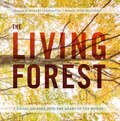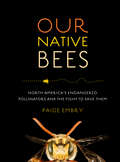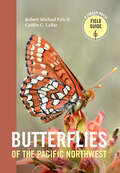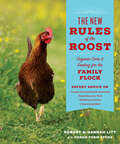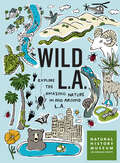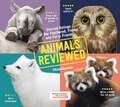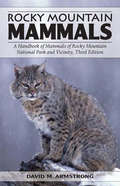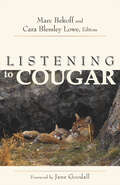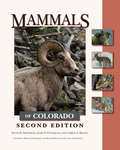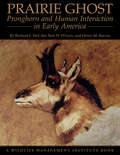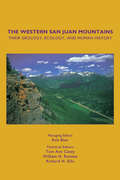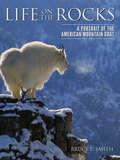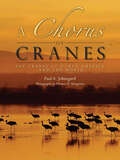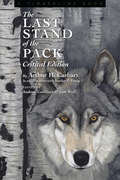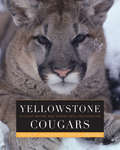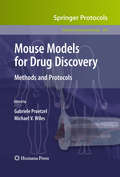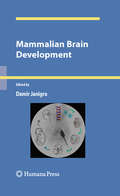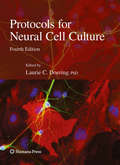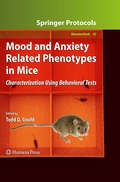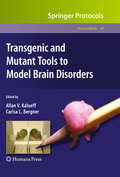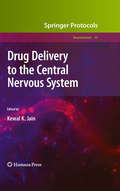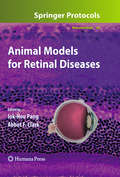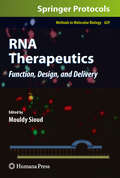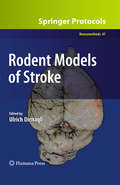- Table View
- List View
The Living Forest: A Visual Journey Into the Heart of the Woods
by Robert Llewellyn Joan MaloofIn a winning combination of fine-art photography and short, lyrical essays, The Living Forest reveals the top-to-bottom mystery, beauty, and interconnectedness of the forest.
Our Native Bees: North America's Endangered Pollinators and the Fight to Save Them
by Paige EmbryOur Native Bees is the result of Paige Embry&’s yearlong quest to learn more about the forgotten, yet fundamental, native bees of North America.
Butterflies of the Pacific Northwest (A Timber Press Field Guide)
by Robert Michael Pyle Caitlin C. LaBarA comprehensive guide to the butterflies of the Pacific Northwest from the region&’s foremost butterfly experts.
The New Rules of the Roost: Organic Care and Feeding for the Family Flock
by Robert Litt Hannah LittA must-have guide for chicken owners looking for deeper information on keeping their flock healthy and happy.
Wild LA: Explore the Amazing Nature in and Around Los Angeles
by Natural History Museum of Los Angeles County Lila M. Higgins Gregory B. PaulyA dynamic, fact-filled guide to the natural world of Los Angeles from the experts at the Natural History Museum.
Animals Reviewed: Starred Ratings of Our Feathered, Finned, and Furry Friends
by Association of Zoos and AquariumsZookeepers hilariously review the animals in their keep—from the anxious aardvark to the zealous zebra shark and every animal in between.
Rocky Mountain Mammals: A Handbook of Mammals of Rocky Mountain National Park and Vicinity, Third Edition
by David M. ArmstrongRevised, updated, and with more than 80 new color photographs, Rocky Mountain Mammals, Third Edition is a nontechnical guide to the mammals of the Southern Rocky Mountains and their foothills, with special emphasis on Rocky Mountain National Park and vicinity. Designed for quick reference and enjoyable reading, Rocky Mountain Mammals offers what most field guides don't - a wealth of fascinating information about each species. In seventy-two species accounts, David M. Armstrong describes each animal and its signs, habits, habitat, and natural history, noting times when seasonal events such as elk sparring occur. Introductory materials and appendices offer rich context and wildlife-watching support, including a checklist with page numbers for quick field reference, an identification key, a glossary, derivations of scientific names, and advice on how, when, and where to watch mammals. Armstrong introduces mammalian evolution, anatomy, and distribution and offers perspective on how the local fauna fits into its geographical setting and into past and potential future faunas of the region. This lavishly illustrated new edition will delight those who live in and visit the high country and foothills of the Southern Rockies and want to identify mammals and learn about their lives. Published in association with the Rocky Mountain Nature Association.
Listening to Cougar
by Cara Blessley LoweThis spellbinding tribute to Puma concolor honors the big cat's presence on the land and in our psyches. In some essays, the puma appears front and center: a lion leaps over Rick Bass's feet, hurtles off a cliff in front of J. Frank Dobie, gazes at Julia Corbett when she opens her eyes after an outdoor meditation, emerges from the fog close enough for poet Gary Gildner to touch. Marc Bekoff opens his car door for a dog that turns out to be a lion. Other works evoke lions indirectly. Biologists describe aspects of cougar ecology, such as its rugged habitat and how males struggle to claim territory. Conservationists relate the political history of America's greatest cat. Short stories and essays consider lions' significance to people, reflecting on accidental encounters, dreams, Navajo beliefs, guided hunts, and how vital mountain lions are to people as symbols of power and wildness. Contributors include: Rick Bass, Marc Bekoff, Janay Brun, Julia B. Corbett, Deanna Dawn, J. Frank Dobie, Suzanne Duarte, Steve Edwards, Joan Fox, Gary Gildner, Wendy Keefover-Ring, Ted Kerasote, Christina Kohlruss, Barry Lopez, BK Loren, Cara Blessley Lowe, Steve Pavlik, David Stoner, and Linda Sweanor. Marc Bekoff has published twenty books, including The Emotional Lives of Animals, and is a professor emeritus of ecology and evolutionary biology at the University of Colorado at Boulder. Writer and photographer Cara Blessley Lowe is author of Spirit of the Rockies and co-founder of The Cougar Fund. BK Loren, in Listening to Cougar: "If the lion, in all its dark, nocturnal otherness, in all its light, internal sameness, does not exist for future generations, if we destroy its habitat, or call open season on it, what could we possibly find to replace it? It is precisely because we fear large predators that we need them. They hold within them so many things that we have lost, or are on the verge of losing, personally and collectively, permanently and forever. If we sacrifice the fear, we also sacrifice the strength, the wildness, the beauty, the awe." Foreword by Jane Goodall
Mammals of Colorado, Second Edition
by David M. Armstrong James P. Fitzgerald Carron A. MeaneyThoroughly revised and updated, Mammals of Colorado, Second Edition is a comprehensive reference on the nine orders and 128 species of Colorado's recent native fauna, detailing each species' description, habitat, distribution, population ecology, diet and foraging, predators and parasites, behavior, reproduction and development, and population status. An introductory chapter on Colorado's environments, a discussion of the development of the fauna over geologic time, and a brief history of human knowledge of Coloradan mammals provide ecological and evolutionary context. The most recent records of the state's diverse species, rich illustrations (including detailed maps, skull drawings, and photographs), and an extensive bibliography make this book a must-have reference. Amateur and professional naturalists, students, vertebrate biologists, and ecologists as well as those involved in conservation and wildlife management in Colorado will find value in this comprehensive volume. Co-published with the Denver Museum of Nature & Science
Prairie Ghost: Pronghorn and Human Interaction in Early America
by Richard E. McCabe Henry M. Reeves Bart W. O'GaraA Wildlife Management Institute Book In this lavishly illustrated volume Richard E. McCabe, Bart W. O'Gara and Henry M. Reeves explore the fascinating relationship of pronghorn with people in early America, from prehistoric evidence through the Battle of Little Bighorn in 1876. The only one of fourteen pronghorn-like genera to survive the great extinction brought on by human migration into North America, the pronghorn has a long and unique history of interaction with humans on the continent, a history that until now has largely remained unwritten. With nearly 150 black-and-white photographs, 16 pages of color illustrations, plus original artwork by Daniel P. Metz, Prairie Ghost: Pronghorn and Human Interaction in Early America tells the intriguing story of humans and these elusive big game mammals in an informative and entertaining fashion that will appeal to historians, biologists, sportsmen and the general reader alike. Winner of the Wildlife Society's Outstanding Book Award for 2005
The Western San Juan Mountains: Their Geology, Ecology, and Human History
by Rob Blair Tom Ann Casey William H. Romme Richard N. EllisThe San Juan Skyway winds its way up, over, and through canyons, mesas, plateaus, mountains, plains, and valleys. The sheer variety of landforms makes the Skyway a veritable classroom for the amateur naturalist and historian. The most complete work published on the natural history of southwest Colorado's majestic mountain system, The Western San Juan Mountains: Their Geology, Ecology, and Human History is designed to be used while exploring the scenic 235-mile paved San Juan Skyway, which passes through Durango, Silverton, Ouray, Telluride, Dolores, and Cortez. The Western San Juan Mountains covers the physical environment, the biological communities, the human history, and points of interest represented on milepost signs along the highway. Some of the many topics covered include: how the San Juan Mountains were formed; why the landscape is so rugged and picturesque; why the vegetation changes from the lowlands to the alpine heights; energy and mineral resources of the area; why these mountains intrigued early explorers; factors that influence the unpredictable weather; and the first-known inhabitants. The contributions to this guide include Fort Lewis College geologists, biologists, archaeologists, historians, and other specialists. Together they have amassed more than one hundred years of study based not only on previous work but on their own research. This generously illustrated guidebook is aimed at all those who wish to understand this intricate mountain system in much greater detail than provided by most picture books.
Yellowstone Wildlife: Ecology and Natural History of the Greater Yellowstone Ecosystem
by Paul A. JohnsgardYellowstone Wildlife is a natural history of the wildlife species that call Yellowstone National Park and the Greater Yellowstone Ecosystem their home. Illustrated with stunning images by renowned wildlife photographer Thomas Mangelsen, Yellowstone Wildlife describes the lives of species in the park, exploring their habitats from the Grand Tetons to Jackson Hole. From charismatic megafauna like elk, bison, wolves, bighorn sheep, and grizzly bears, to smaller mammals like bats, pikas, beavers, and otters, to some of the 279 species of birds, Johnsgard describes the behavior of animals throughout the seasons, with sections on what summer and autumn mean to the wildlife of the park, especially with the intrusion of millions of tourists each year. Enhanced by Mangelsen’s wildlife photography, Yellowstone Wildlife reveals the beauty and complexity of these species’ intertwined lives and that of Yellowstone’s greater ecosystem.
Life on the Rocks: A Portrait of the American Mountain Goat
by Bruce L. SmithThe American mountain goat is one of the most elusive and least familiar species of hoofed mammals in North America. Confined to the remote and rugged mountains of the western United States and Canada, these extraordinary mountaineers are seldom seen or encountered, even by those who patiently study them. Life on the Rocks offers an intimate portrayal of this remarkable animal through the eyes and lens of field biologist and photographer Bruce Smith. Color photographs and accounts of Smith's personal experiences living in Montana's Selway-Bitterroot Wilderness Area accompany descriptions of the American mountain goat's natural history. Smith explores their treacherous habitat, which spans the perilous cliffs and crags of the Rocky, Cascade, and Coast mountain ranges. The physical and behavioral adaptations of these alpine athletes enable them to survive a host of dangers, including six-month-long winters, scarce food sources, thunderous avalanches, social strife, and predators like wolves, bears, lions, wolverines, and eagles. Smith also details the challenges these animals face as their territory is threatened by expanding motorized access, industrial activities, and a warming climate. Life on the Rocks showcases the elegance and charm of this little-known creature, thriving in some of North America's harshest wilderness. Smith's volume will appeal to wildlife enthusiasts, wildland travelers, and conservationists interested in the future of the American mountain goat. 2014 National Outdoor Book Award winner: Nature & Environment and co-winner: Design and Artistic Merit
A Chorus of Cranes: The Cranes of North America and the World
by Paul A. Johnsgard“Since long before medieval times cranes have been considered messengers of the gods, calling annually from on high to remind humans below of the passing years and of their own mortality. Now it is up to humans to take responsibility for controlling our own fate—and also to cry out to protect not only cranes but all the other wonderful creatures that share our increasingly fragile and threatened planetary ecosystem with us." —Paul A. Johnsgard, from the acknowledgments Accompanied by the stunning photography of Thomas D. Mangelsen, A Chorus of Cranes details the natural history, biology, and conservation issues surrounding the abundant sandhill crane and the endangered whooping crane in North America. Author Paul A. Johnsgard, one of the leading authorities on cranes and crane biology, describes the fascinating social behaviors, beautiful natural habitats, and grueling seasonal migrations that have stirred the hearts of people as far back as medieval times and garnered the crane a place in folklore and mythology across continents. Johnsgard has substantially updated and significantly expanded his 1991 work Crane Music, incorporating new information on the biology and status of these two North American cranes and providing abbreviated summaries on the other thirteen crane species of the world. The stories of these birds and their contrasting fates provide an instructive and moving history of bird conservation in North America. A Chorus of Cranes is a gorgeous and invaluable resource for crane enthusiasts, birders, natural historians, and conservationists alike. The University Press of Colorado gratefully acknowledges the generous support of the Iain Nicholson Audubon Center at Rowe Sanctuary, Audubon Nebraska, Ron and Judy Parks, Wagon Tongue Creek Farm, and the Trull Foundation toward the publication of this book.
The Last Stand of the Pack: Critical Edition (Timberline Books)
by Arthur CarhartThis critical edition explores the past and future of wolves in Colorado. Originally published in 1929, The Last Stand of the Pack is a historical account of the extermination of what were then believed to be the last wolves in Colorado. Arthur H. Carhart and Stanley P. Young describe the wolves’ extermination and extoll the bravery of the federal trappers hunting them down while simultaneously characterizing the wolves as cunning individuals and noble adversaries to the growth of the livestock industry and the settlement of the West. This is nature writing at its best, even if the worldview expressed is at times jarring to the twenty-first-century reader. Now, almost 100 years later, much has been learned about ecology and the role of top-tier predators within ecosystems. In this new edition, Carhart and Young’s original text is accompanied by an extensive introduction with biographical details on Arthur Carhart and an overview of the history of wolf eradication in the west; chapters by prominent wildlife biologists, environmentalists, wolf reintroduction activists, and ranchers Tom Compton, Bonnie Brown, Mike Phillips, Norman A. Bishop, and Cheney Gardner; and an epilogue considering current issues surrounding the reintroduction of wolves in Colorado. Presenting a balanced perspective, these additional chapters address views both in support of and opposed to wolf reintroduction. Coloradans are deeply interested in wilderness and the debate surrounding wolf reintroduction, but for wolves to have a future in Colorado we must first understand the past. The Last Stand of the Pack: Critical Edition presents both important historical scholarship and contemporary ecological ideas, offering a complete picture of the impact of wolves in Colorado.
Yellowstone Cougars: Ecology before and during Wolf Restoration
by Toni K. Ruth Polly C. Buotte Maurice G. HornockerYellowstone Cougars examines the effect of wolf restoration on the cougar population in Yellowstone National Park—one of the largest national parks in the American West. No other study has ever specifically addressed the theoretical and practical aspects of competition between large carnivores in North America. The authors provide a thorough analysis of cougar ecology, how they interact with and are influenced by wolves—their main competitor—and how this knowledge informs management and conservation of both species across the West. Of practical importance, Yellowstone Cougars addresses the management and conservation of multiple carnivores in increasingly human-dominated landscapes. The authors move beyond a single-species approach to cougar management and conservation to one that considers multiple species, which was impossible to untangle before wolf reestablishment in the Yellowstone area provided biologists with this research opportunity. Yellowstone Cougars provides objective scientific data at the forefront of understanding cougars and large carnivore community structure and management issues in the Greater Yellowstone Ecosystem, as well as in other areas where wolves and cougars are reestablishing. Intended for an audience of scientists, wildlife managers, conservationists, and academics, the book also sets a theoretical precedent for writing about competition between carnivorous mammals.
Mouse Models for Drug Discovery: Methods and Protocols (Methods in Molecular Biology #602)
by Gabriele Proetzel and Michael V. WilesAs the drug discovery process shifts more and more toward specifically targeting pathways and molecules, model systems continue to increase in importance, and the mouse, with its versatility, ease of use, and remarkable similarity to the human genome, has clearly risen to the forefront of animal model studies. In Mouse Models for Drug Discovery: Methods and Protocols, experts in the field present some background for those less familiar with mice as experimental model platforms as well as a collection of techniques involving general methods as well as specific disease topics such as type 1 and 2 diabetes, cardiovascular disease, arthritis, skin disorders, cancer, the use of behavioral models for depression and anxiety, neurodegenerative diseases, neuromuscular diseases, and infectious diseases. Written in the highly successful Methods in Molecular Biology™ series format, chapters include introductions to their respective topics, lists of the necessary materials and reagents, step-by-step, readily reproducible laboratory protocols, and notes on troubleshooting and avoiding known pitfalls. Authoritative and easy-to-use, Mouse Models for Drug Discovery: Methods and Protocols will stimulate those not familiar with the power of the mouse and its potential for the drug discovery process, and it will encourage the development of new models and new ways to utilize existing models in order to further the use of this dynamic animal in this vital field.
Mammalian Brain Development (Contemporary Neuroscience)
by Damir JanigroDenis Noble Nearly a decade after completion of the first draft of the entire Human Genome sequence we are in a better position to assess the nature and the consequences of that heroic achievement, which can be seen as the culmination of the molecular biological revolution of the second half of the twentieth century. The achievement itself was celebrated at the highest levels (President and Prime Minister) on both sides of the Atlantic, and rightly so. DNA sequencing has become sufficiently c- mon now, even to the extent of being used in law courts, that it is easy to forget how technically difficult it was and how cleverly the sequencing teams solved those problems in the exciting race to finish by the turn of the century [1, 2]. The fanfares were misplaced, however, in an important respect. The metaphors used to describe the project and its biological significance gave the impression to the public at large, and to many scientists themselves, that this sequence would reveal the secrets of life. DNA had already been likened to a computer program [3]. The “genetic program” for life was therefore to be found in those sequences: A kind of map that had simply to be unfolded during development. The even more colo- ful “book of life” metaphor gave the promise that reading that book would lead to a veritable outpouring of new cures for diseases, hundreds of new drug targets, and a brave new world of medicine.
Protocols for Neural Cell Culture (Springer Protocols Handbooks)
by Laurie C. DoeringSince the conception of this acclaimed series of volumes examining neural tissue culture, the expansion of neuroscience has continued to produce vital discoveries that utilize tissue culture methodologies. The expert contributors to the fourth edition of Protocols for Neural Cell Culture refine existing protocols and present the emerging new techniques and culture media formulations linked with the many advances in neuroscience. While highlighting updated experimental procedures for many of the classical neural tissue culture preps, the volume addresses topics such as regenerative medicine and the methods to grow and expand embryonic and adult neural stem cells. Essential techniques for the isolation, expansion, and cryopreservation of neural tissue from mouse, rat, and human sources are covered, as well as methods to assess aspects of cell function (calcium imaging) and cell death. With its detailed, step-by-step laboratory protocols, this volume provides the kind of detailed description and implementation advice that is crucial for getting optimal results. Authoritative and cutting-edge, Protocols for Neural Cell Culture, Fourth Edition continues the previous editions’ tradition of exceptional quality and thorough coverage in tissue culture protocols for today’s neuroscience in order to inspire researchers in the field to further explore this imperative area of study.
Mood and Anxiety Related Phenotypes in Mice: Characterization Using Behavioral Tests (Neuromethods #42)
by Todd D. GouldAffecting approximately twenty percent of the world population, mood and anxiety disorders have been the subject of ever-increasing research. This increased research parallels a remarkable growth in the use of the laboratory mouse as a tool to understand the biological and genetic basis of mood and anxiety disorders as well as to develop improved treatments. In Mood and Anxiety Related Phenotypes in Mice: Characterization Using Behavioral Tests, world-renowned researchers provide an overview of behavioral approaches utilized in the characterization of mood and anxiety related behaviors in mice as well as commonly used behavioral assays to assess the potential antidepressant and anxiolytic efficacy of novel compounds. As a volume in the successful Neuromethods™ series, the chapters provide authoritative reviews including up-to-date detailed protocols of the most commonly used approaches in the field. Mood and Anxiety Related Phenotypes in Mice: Characterization Using Behavioral Tests is an ideal resource for scientists actively pursuing or interested in establishing behavioral protocols in their laboratories, while also serving as a reference for those students, scientists, and practitioners who have an interest in better understanding the preclinical behavioral methods used in mood and anxiety research.
Transgenic and Mutant Tools to Model Brain Disorders (Neuromethods #44)
by Allan V. Kalueff and Carisa L. BergnerAs the presence of genetically modified animal models in research laboratories has multiplied, the role of genetic factors in the pathogenesis of brain disorders has become particularly important. The refinement of molecular genetic methods has continued to broaden our understanding of the genetic factors associated with a variety of disorders. In "Transgenic and Mutant Tools to Model Brain Disorders", leading scientists specializing in this field contribute a timely collection of recent advances featuring a vast array of topics in order to contribute to the diverse approaches taken toward the evaluation of genetically modified models in biomedical research. Opening with several chapters covering general aspects of genetically modified animal models, the book then continues with detailed chapters on models of specific human brain disorders, including OCD, Rett Syndrome, anxiety disorders, depression, and schizophrenia. As a volume in the successful Neuromethods™ series, the chapters provide authoritative reviews covering the most commonly used approaches in the field. Cutting-edge and concise, "Transgenic and Mutant Tools to Model Brain Disorders" offers a comprehensive and descriptive overview on a variety of topics in neuroscience and biological psychiatry.
Drug Delivery to the Central Nervous System (Neuromethods #45)
by Kewal K. JainPlaying an important role in the treatment of neurological disorders, the delivery of drugs to central nervous system (CNS), both administered directly and administered systematically for targeted action, encounters a major challenge in the form of the blood-brain barrier (BBB), which limits the access of drugs to the brain substance. In Drug Delivery to the Central Nervous System, experts in the field present essential methods used to deliver therapeutics across the BBB, both in experimental animals and in humans. In addition to those methods, several overviews of innovative methods and their applications are presented in order to give a glimpse of the future of this research. As a volume in the successful Neuromethods series, this book presents its protocols with the kind of detailed description and implementation advice that is crucial for getting optimal results. Authoritative and cutting-edge, Drug Delivery to the Central Nervous System serves as an ideal guide to scientists continuing to pursue knowledge of the delicate interactions between pharmaceuticals and the brain.
Animal Models for Retinal Diseases (Neuromethods #46)
by Iok-Hou Pang and Abbot F. ClarkAffecting over a hundred million individuals worldwide, retinal diseases are among the leading causes of irreversible visual impairment and blindness, and appropriate study models, especially animal models, are essential to furthering our understanding of the etiology, pathology, and progression of these endemic diseases. In Animal Models for Retinal Diseases, recognized experts in the field highlight valuable techniques as well as animal models for the prominent retinal diseases in order to aid in the evaluation, development, and improvement of therapeutic strategies. Beginning with an overview of the morphology of the retina, visual behavior, and genetics and genomics approaches for retinal research, the book continues by covering animal models for the research of specific human retinal diseases, e.g., retinal degeneration, age-related macular degeneration, retinopathy of prematurity, diabetic retinopathy, glaucoma, retinal ischemia, and retinal inflammation. As a volume in the successful Neuromethods series, the chapters provide authoritative reviews of the most commonly used approaches in the field. Vital and easy to use, Animal Models for Retinal Diseases serves to support the important future research of ocular investigators, ophthalmologists, and neuroscientists currently delving into this fascinating field of study.
RNA Therapeutics: Function, Design, and Delivery (Methods in Molecular Biology #629)
by Mouldy SioudCentral to the synthesis of proteins, the performance of catalysis, and many other physiological processes, the aberrant expression of which can be linked to human diseases including cancers, RNA has proven to be key target for therapeutics as well as a tool for therapy. In RNA Therapeutics: Function, Design, and Delivery, expert contributors from a broad spectrum of scientific backgrounds highlight the roles that messenger RNAs and small RNAs can play in biology and medicine. While covering the five major RNA-based drugs, namely the use of ribozymes to cleave and/or correct mRNA transcript, the use of siRNA for targeted silencing of gene transcripts, the use of aptamers, like short RNA molecules, for neutralizing the protein functions, the use mRNA-transfected DCs to activate immune system against tumor cells, as well as the use of RNA to reprogram T and/or DC cell function, this extensive volume brings together the fields of coding (mRNA) and non-coding RNA such as ribozymes, RNAse P, siRNAs, and miRNAs into one convenient source. Written in the highly successful Methods in Molecular Biology™ series format, the cutting-edge protocol chapters contain introductions to their respective topics, lists of the necessary materials and reagents, step-by-step, readily reproducible laboratory protocols, and practical tips on troubleshooting and avoiding known pitfalls. Also, the book contains several excellent reviews for teaching purposes. Authoritative and comprehensive, RNA Therapeutics: Function, Design, and Delivery provides key models and tools which will assist researchers in increasing our understanding of RNA functions, modifications, and their involvement in diseases in order to lead to the design of vital new RNA-based therapeutics.
Rodent Models of Stroke (Neuromethods #47)
by Ulrich DirnaglIn view of the numerous failures of clinical trials aimed at improving stroke therapy, the role and potential benefit of experimentally modeling focal cerebral ischemia in rodents has been debated. When methods of systematic review and metaanalyis are applied, however, it turns out that experimental models actually faithfully predicted the negative outcomes of clinical trials. In addition, thrombolysis and neuroprotection by hypothermia, first described in animal models, are key examples of treatment modalities that have made it successfully into clinical practice. In Rodent Models of Stroke, an international consortium of authors aims at critically addressing the issues on a very practical level, from choosing the model and outcome measures, designing the experiment, conducting and analyzing it, to reporting it in a scientific publication. The structure and content of the book reflect both the authors’ longstanding expertise in experimental and clinical stroke research and their roles in training the scientific community in the tools of the trade. As a volume in the successful Neuromethods series, the chapters provide authoritative reviews of the most commonly used, well-honed approaches in the field today. Stimulating and easy-to-use, Rodent Models of Stroke will help its readers understand the limitations and the opportunities of modeling stroke in rodents and enable them to conduct experiments which will not only improve our understanding of the pathophysiology of this devastating disorder but also serve as the basis for developing new highly effective treatments.
